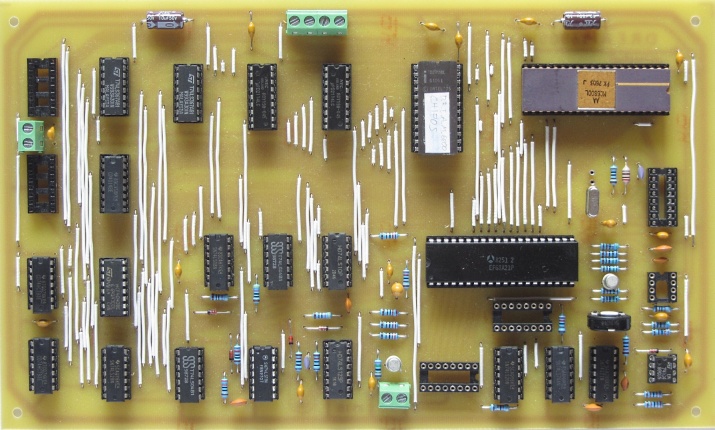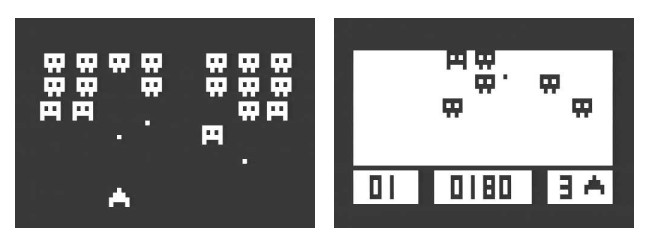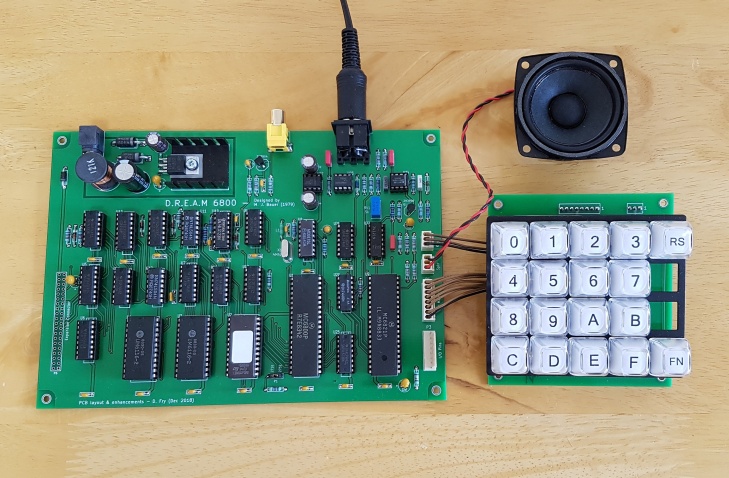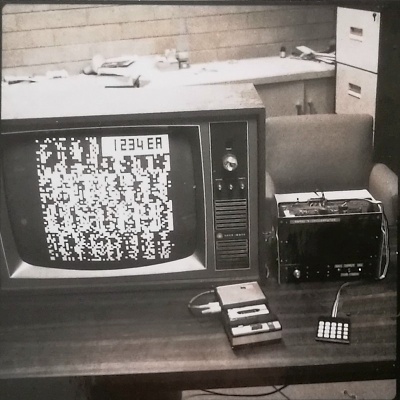| Welcome to the official DREAM 6800 Archive Site 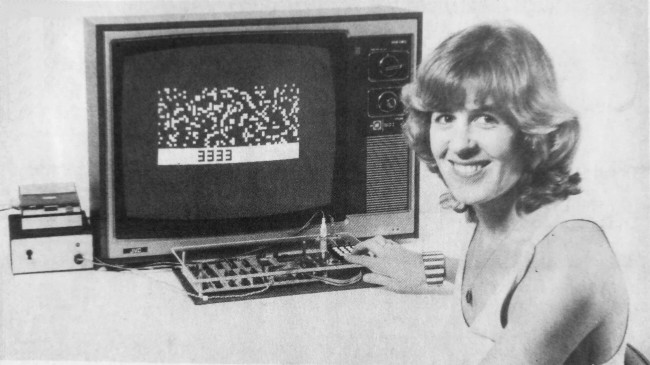 DREAM system pictured with Adriana Hill at Electronics Australia office (1979) The "DREAM-6800" was a popular build-it-yourself single-board micro-computer which I designed in 1978. The project was published in Electronics Australia magazine in 1979. The DREAM was a ridiculously simple hobby computer with 2K bytes of memory that played game programs on a TV. The 1KB EPROM (1024 bytes!) contained a simple interpretive programming language known as "CHIP-8", devised by Joe Weisbecker of RCA Labs. I developed a CHIP-8 interpreter to run on the Motorola 6800 processor. CHIP-8 originally ran on the RCA 'COSMAC' VIP board. It was amazing to see what could be done with the available memory and a "chunky graphics" display of just 64 x 32 pixels -- for example, "Dream Invaders", a crude version of Space Invaders, as adrenalin-pumping as the real thing.
Since there seems to be on-going interest in the DREAM 6800 computer on the web, I have posted various Dream 6800 archive material here for downloading. Original E/A magazine articles... Part 1 - May 1979 (PDF ~ 3.7MB) Part 2 - June 1979 (PDF ~ 3.8MB) Part 3 - July 1979 (PDF ~ 3.2MB) Part 4 - Aug. 1979 (PDF ~ 2.3MB) 4KB RAM Expansion Board - E/A Dec. 1980 (PDF ~ 1.2MB) Later publications ... CHIPOS EPROM and 6800 Assembler code (ZIP ~ 10KB) CHIPOS Calls Manual (PDF ~ 800kB) Game Programs (ZIP folder of MP3 audio files ~ 2MB) Google "CHIP-8" to find many more games and other programs. Dream Invaders (ZIP ~ 4.8MB) Dream Invaders 6800 assembler code -- restoration by Craig Jones (2023)
Sound Effects Add-on (PDF ~ 2MB) Hi-Res Display Mod. (PDF ~ 1.2MB) CHIPOS code modified to support Hi-Res display (128 x 64 px) - courtesy Craig Jones The text in the published E/A articles referred to a timing diagram for the video generator circuit. The editor of the magazine chose not to include the timing diagram, but neglected to omit my reference to it in the text. To help (or confuse) those attempting to understand its workings, here is the original timing diagram for the video display controller circuit... Video generator timing diagram (JPG ~ 800kB)___ CHIPOS 6800 Assembler source code - Restoration by Lucien Gisclong, 2019 The original source code for the CHIPOS ROM was lost, along with the 6800 cross-assembler (written in FORTRAN) used to generate the object code. A while back, I got an email from Lucien Gisclong (France) who has restored the original source file. Lucien built a Dream-6800 using David's 40th anniversary board and got it going. Thanks, Lucien, for sharing your work. Single 5V Supply Mod's Board modifications to allow operation with a single 5V power supply are possible. View/download marked-up schematic The
tape output circuit (FSK modulator) using the LM566 function generator IC
still needs a negative 5V supply. This can be done with an add-on
low-current DC-DC converter module from AliExpress. Replacement tape modulator and beeper circuit Greg, founder of 'Digicool Things', has developed a neat little circuit board which replaces the tape modem and beeper driver using readily available parts, requiring only a single 5V supply. Greg's board also supports a replacement keypad with 20 keys, providing 4 "function" keys.* The board connects to the PIA sockets on the Dream board, eliminating all of the original audio and keypad circuitry. Schematic, Gerber files and comprehensive documentation are available on the GitHub repository. * Some changes to the 'CHIPOS' code are required to support the extra function keys. Also, be sure to check out Greg's modular Dream-6809 project on his 'Digicool Things' website! It's a re-creation of the Dream using a 128 x 64 pixel OLED display...
40th Anniversary Revamp by David Fry (2019)
I am delighted to announce that vintage computer enthusiast, David Fry (UK), has completed an elegant re-design of the DREAM using a double-sided PCB (pictured above). It has an on-board switchmode regulator for the +5V supply and a DC/DC converter for negative 5V. Memory has been upgraded to 4KB using two 6116 RAM chips. The EPROM can be a 2716 or 2732 type. Otherwise, David's design remains faithful to the original. The download pack includes KiCad PCB design files and Gerber files for board fabrication. 40th Anniversary Revamp documentation pack (ZIP ~ 4MB) -- Posted January 2019 Errata & revised build notes (April 2019) DREAM-6800 Emulator (and more) by Tobias V. Langhoff Explore the DREAM-6800 and its CHIP-8 interpreter, without needing any hardware! This app faithfully emulates the CHIP-8 language interpreter, including 4 extra instructions which were omitted from the original publication by Joe Weisbecker ("An Easy Programming System", Byte magazine, December 1978). Not only CHIP-8... The software accurately emulates the M6800 processor instruction set, so that machine-code subroutines, or whole programs, will run. For details, visit Tobias V Langhoff blog site Origins of the Dream While tutoring in Computer
Science at Deakin University in the '70's, I had a strong
interest in micro-processors... of course! In 1976, Motorola
released a low-cost 6800 evaluation kit called the "D1 kit"
(bare PCB and major IC's -- M6800, M6810 RAM, M6820 PIA,
M6850 ACIA, etc). Deakin could not justify the expense of
a Motorola "Exorcisor" development rig, so
I built up my own 6800 "development system" based on the D1 board
and a bunch of wire-wrap edge connectors for a backplane. I made a RAM expansion board for the D1 with 4K
bytes. The D1 kit had no keypad or LED display... that came later with the famous "D2 kit". Initially, I used a "spare" ASR33 Teletype as the user interface for the D1 system. Later, a CRT terminal. In those days, you had to pay exorbitant prices ($1,000's) for a cross-assembler, so I wrote my own in FORTRAN to run on Deakin's DEC 'System 20' mainframe. It was a primitive assembler (no macros), but way better than hand-assembling machine code. When I got bored with text I/O (and my Teletype got relegated to a MITS Altair 8800 project), I designed and built a video graphics controller for the D1 kit. It had a resolution of 64 x 64 pixels, using 512 bytes of video RAM mapped into the 6800 address space. I submitted the video board design to E/A editor Jamieson Rowe for consideration as a DIY project. Jim poo-poo'd the idea, saying (quite rightly) that it was too complicated and too expensive for the average hobbyist, requiring a CPU board and RAM board in addition.
A few months later, I saw an
advertisement in Byte magazine for a single-board computer known as the
RCA COSMAC "VIP", designed by Joe Weisbecker of RCA Labs who,
incidentally, also designed the silicon for the RCA 1802 (CMOS) micro-processor
chip on which the VIP board was based. The VIP board had a custom video
controller chip producing a 64 x 32 pixel monochrome display, a
hex keypad, minimal RAM (1KB, I think) plus an EPROM with a clever
interpretive programming language Joe called "CHIP-8", coded using hex
numbers instead of the more conventional ASCII text (as in BASIC,
Forth, etc). This inspired the DREAM-6800
which I admit was a blatant rip-off of the VIP concept, except
that the Dream video controller circuit was designed around
"discrete" 74-series and 4000-series logic IC's to generate a
PAL-compatible display format (50Hz vertical refresh rate, vs
60Hz for the VIP). And my audio tape modem circuit design was
100% original and much simpler than both the VIP and Motorola D2 kit
tape circuits. I submitted a much simplified and refined Dream 6800 design to E/A, including CHIP-8 interpreter in EPROM and a bunch of CHIP-8 games (also ripped off from the VIP). This time Jim liked the idea... a DIY project he could spread over several months, without the magazine having to do any development work, with all the text provided on a silver plate! By the way, I did ask permission from Joe Weisbecker to clone his CHIP-8 language and a few games. He was really chuffed that his idea had caught on "down under". In hindsight, I regret down-grading the video format to 64 x 32 pixels. This was done not only to minimize price and board size, but also for CHIP-8 program compatibility. But with RAM prices dropping fast, I should have made it 128 x 64 pixels (taking 1KB of RAM), at least. The PCB would have been bigger, but still not as big as the Cosmac VIP. Also, the VIP game programs could have been modified to run on a larger screen format, but I was under pressure from E/A to finish the articles for publication. Annoyingly, by the time E/A was ready to publish the first instalment, higher density RAM and (single 5V) EPROM chips were readily available. But a further delay due to a design revision would have been unacceptable. By the way, I had planned a successor to the Dream-6800... a "Dream-6809" which was to have a much improved display resolution (i.e. 160 x 100 pixels) in colour, with "extended" CHIP-8 language, etc. Regrettably, personal circumstances got in the way and the design was never completed. Probably just as well -- there was a plethora of low-cost hobby computers on the market at the time, most notably the Tandy "CoCo" which was based on the marvellous 6809 micro-processor.
For further information
or technical help to build or resurrect a Dream-6800, send email to: |
